.gif)
Palm Court (Alexandria Hotel)
Encyclopedia
The Palm Court, also known at other times as the Franco-Italian Dining Room, the Grand Ballroom and the Continental Room, is a ballroom at the Hotel Alexandria
in Downtown Los Angeles
, California
. In its heyday from 1911 to 1922, it was the scene of speeches by U.S. Presidents William Howard Taft
and Woodrow Wilson
and Gen. John J. Pershing
. It is also the room where Paul Whiteman
, later known as the "Jazz King", got his start as a bandleader in 1919, where Rudolph Valentino
danced with movie starlets, and where Hollywood held its most significant balls during the early days of the motion picture business. Known for its history and its stained-glass Tiffany skylight, noted Los Angeles columnist Jack Smith
called it "surely the most beautiful room in Los Angeles." The Palm Court was designated as a City of Los Angeles Historic-Cultural Monument (HCM#80) in 1971.
was designed by noted Los Angeles architect, John Parkinson
. In 1911, Parkinson and Bergstom were hired to design an addition that would double the capacity. The Palm Court was part of the 1911 addition. When the design of the new "crystal palmroom" was announced, the Los Angeles Times wrote:
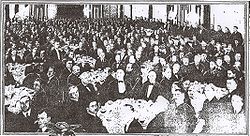
When the new ballroom opened in October 1911, it was acknowledged for its beauty. The room was "christened" in a gala attended by 385 of the city's "most prominent names." The Alexandria orchestra played throughout the evening," and the Los Angeles Times reported the next day on the city's spectacular new room:
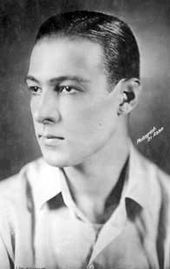 For the next 12 years (until the opening of the Biltmore in 1923), the Palm Court was the city's most prestigious ballroom event location, hosting receptions for the likes of President Woodrow Wilson
For the next 12 years (until the opening of the Biltmore in 1923), the Palm Court was the city's most prestigious ballroom event location, hosting receptions for the likes of President Woodrow Wilson
and Gen. John J. Pershing
, as well as balls where Hollywood's silent film stars and early movie moguls mingled. By 1912, the Alexandria had become such an important gathering place that the Los Angeles Times wrote the following:
Rudolph Valentino
, whose untimely death at age 31 caused mass hysteria among his female fans, was a regular visitor to the dances held at the Alexandria's great ballroom. Actress Claire Windsor
recalled that, when she and Valentino were "$75-a-week extras", they rode the streetcar from Westlake Park to dance in the Palm Court. Silent movie actress Mary MacLaren
later recalled that her mother had "blighted a blossoming romance" with Valentino when she would not allow her to go dancing with "Rudy" at the Alexandria. A third actress, Marjorie Bennett
, also recalled meeting Valentino at a tea dance at the Alexandria, when Valentino was "a handsome aspiring Italian actor, Rodolpho d'Antonguolla."
In the Alexandria's heyday, movie stars and other celebrities, including Valentino, Mary Miles Minter
, Sarah Bernhardt
, Enrico Caruso and Jack Dempsey
were guests. Charlie Chaplin
reportedly kept a suite at the Alexandria and did improvisations in the lobby, and western star Tom Mix
reportedly rode his horse through the lobby. The large oriental rug in the lobby was called the "million-dollar carpet", because there was purportedly a $1 million worth of business done there every day. It was there that D.W. Griffith, Mary Pickford
and Douglas Fairbanks
met in 1919 to form United Artists
. U.S. Presidents Theodore Roosevelt
, William Howard Taft
and Woodrow Wilson
, and many foreign dignitaries, also stayed at the hotel while visiting Los Angeles.

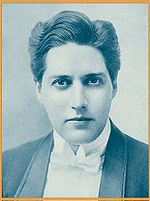
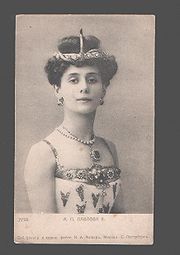
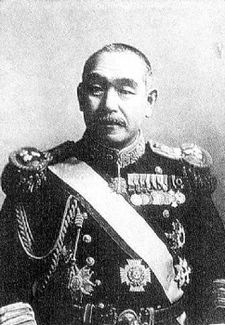
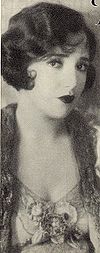
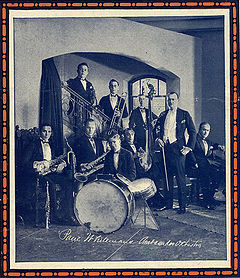

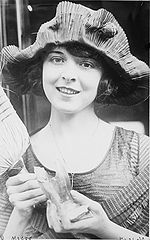 From 1911 to 1923, the Alexandria ballroom (now known as the Palm Court) was the site of many of the city's most important gatherings. The following list identifies some of the notable events associated with the room.
From 1911 to 1923, the Alexandria ballroom (now known as the Palm Court) was the site of many of the city's most important gatherings. The following list identifies some of the notable events associated with the room.
1911
1912
1913
1915
1916
1918
1919
1920
1921
1922
opened in 1923 and replaced the Alexandria as the city's most prestigious hotel. The opening of the luxurious Biltmore put an immediate dent in the Alexandria's business. In October 1923, the Los Angeles Times wrote:
During the 1950s and 1960s, the Grand Ballroom (as the Palm Court was then known) was used as a training ring for boxers. In 1958, Pajarito Moreno
drew crowds of 800 people to his training camp at the Palm Room prior to his featherweight title match with Kid Bassey
. Sports columnist Braven Dyer noted, that on learning that Moreno was training in a ballroom, his barber sarcastically commented,
In 1960, a Los Angeles Times article described the scene at the Palm Room where a dollar bought admission to watch world bantamweight boxing champion Jose Becerra
and welterweight Battling Torres training for fights to be held at the Coliseum:
Noting that Woodrow Wilson
had once given a speech in the same room, the writer observed: "The (boxing) session ends to long applause -- probably more than President Wilson received. After all, he packed no punch."
said of the Palm Court: "It is a room of excellent proportions, and, softly lighted by its lovely oval skylight, it is surely the most beautiful room in Los Angeles." In 2005, the Los Angeles Times called the Palm Court an architectural gem:
The Palm Court was designated a Historic Cultural Monument (HCM #80) in 1971. As of 2008, the Alexandria had been converted to apartments.
The Blankenship Ballet Company's May 2010 "Cuban Ballet & Dance Extravaganza" in Palm Court was documented by Supreme Master Television and played in multiple languages and dialects all over the world.
Hotel Alexandria
The Hotel Alexandria is a historic building that was constructed as a luxury hotel at the beginning of the Twentieth Century in what was then the heart of Downtown Los Angeles. As the business center of the city moved gradually westward, the hotel decayed and gradually devolved into an SRO hotel...
in Downtown Los Angeles
Downtown Los Angeles
Downtown Los Angeles is the central business district of Los Angeles, California, United States, located close to the geographic center of the metropolitan area...
, California
California
California is a state located on the West Coast of the United States. It is by far the most populous U.S. state, and the third-largest by land area...
. In its heyday from 1911 to 1922, it was the scene of speeches by U.S. Presidents William Howard Taft
William Howard Taft
William Howard Taft was the 27th President of the United States and later the tenth Chief Justice of the United States...
and Woodrow Wilson
Woodrow Wilson
Thomas Woodrow Wilson was the 28th President of the United States, from 1913 to 1921. A leader of the Progressive Movement, he served as President of Princeton University from 1902 to 1910, and then as the Governor of New Jersey from 1911 to 1913...
and Gen. John J. Pershing
John J. Pershing
John Joseph "Black Jack" Pershing, GCB , was a general officer in the United States Army who led the American Expeditionary Forces in World War I...
. It is also the room where Paul Whiteman
Paul Whiteman
Paul Samuel Whiteman was an American bandleader and orchestral director.Leader of the most popular dance bands in the United States during the 1920s, Whiteman's recordings were immensely successful, and press notices often referred to him as the "King of Jazz"...
, later known as the "Jazz King", got his start as a bandleader in 1919, where Rudolph Valentino
Rudolph Valentino
Rudolph Valentino was an Italian actor, and early pop icon. A sex symbol of the 1920s, Valentino was known as the "Latin Lover". He starred in several well-known silent films including The Four Horsemen of the Apocalypse, The Sheik, Blood and Sand, The Eagle and Son of the Sheik...
danced with movie starlets, and where Hollywood held its most significant balls during the early days of the motion picture business. Known for its history and its stained-glass Tiffany skylight, noted Los Angeles columnist Jack Smith
Jack Smith (columnist)
Jack Clifford Smith was a journalist, author, and newspaper columnist who wrote about Los Angeles during its period of greatest growth and increasing influence...
called it "surely the most beautiful room in Los Angeles." The Palm Court was designated as a City of Los Angeles Historic-Cultural Monument (HCM#80) in 1971.
Palm Court's heyday 1911-1922
Built in 1906, the eight-story Hotel AlexandriaHotel Alexandria
The Hotel Alexandria is a historic building that was constructed as a luxury hotel at the beginning of the Twentieth Century in what was then the heart of Downtown Los Angeles. As the business center of the city moved gradually westward, the hotel decayed and gradually devolved into an SRO hotel...
was designed by noted Los Angeles architect, John Parkinson
The Parkinsons
John B. and Donald D. Parkinson were a father-and-son architectural team operating in Los Angeles in the early 20th century.-Early years:...
. In 1911, Parkinson and Bergstom were hired to design an addition that would double the capacity. The Palm Court was part of the 1911 addition. When the design of the new "crystal palmroom" was announced, the Los Angeles Times wrote:

"The room will be one of the largest of its kind in California and will be available for social affairs of every nature. Its primary object, however, will be more of a furnishing a convenient place for afternoon teas, card parties and evening receptions."
When the new ballroom opened in October 1911, it was acknowledged for its beauty. The room was "christened" in a gala attended by 385 of the city's "most prominent names." The Alexandria orchestra played throughout the evening," and the Los Angeles Times reported the next day on the city's spectacular new room:
"The great room, over one hundred feet in length and seventy-five feet in width, was a sunburst of light. Great crystal chandeliers blazed from a dozen vantage points, while softer and smaller lights were placed along the four sides of the room. ... The perfection and symphony of the great room held the guests spellbound upon their arrival. As the stately ladies and gentlemen entered the salon the pause each made at the threshold as with intense interest they swept the salon with their gaze was noticeable."

Woodrow Wilson
Thomas Woodrow Wilson was the 28th President of the United States, from 1913 to 1921. A leader of the Progressive Movement, he served as President of Princeton University from 1902 to 1910, and then as the Governor of New Jersey from 1911 to 1913...
and Gen. John J. Pershing
John J. Pershing
John Joseph "Black Jack" Pershing, GCB , was a general officer in the United States Army who led the American Expeditionary Forces in World War I...
, as well as balls where Hollywood's silent film stars and early movie moguls mingled. By 1912, the Alexandria had become such an important gathering place that the Los Angeles Times wrote the following:
"What Union Square was to old New York, what Forty-second street is to the present metropolis, and what the vicinity of the Cort Theater is to San Francisco, the Alexandria mezzanine seems to be to theatrical Los Angeles. ... Hardly ever does the day pass in which some nationally-known actor or actress does not linger in the low settees or pause at the golden rail, looking down into the lobby below -- pausing, lingering, while in whispered tones behind rises the chatter that his or her presence has caused."
Rudolph Valentino
Rudolph Valentino
Rudolph Valentino was an Italian actor, and early pop icon. A sex symbol of the 1920s, Valentino was known as the "Latin Lover". He starred in several well-known silent films including The Four Horsemen of the Apocalypse, The Sheik, Blood and Sand, The Eagle and Son of the Sheik...
, whose untimely death at age 31 caused mass hysteria among his female fans, was a regular visitor to the dances held at the Alexandria's great ballroom. Actress Claire Windsor
Claire Windsor
Claire Windsor was a notable American film actress of the silent screen era.-Early life:Windsor was born Clara Viola Cronk in 1892 to George Edwin and Rosella R. Fearing Cronk in Marvin, Phillips County, Kansas of Scandinavian heritage. Her parents later moved to Cawker City, Kansas when she was...
recalled that, when she and Valentino were "$75-a-week extras", they rode the streetcar from Westlake Park to dance in the Palm Court. Silent movie actress Mary MacLaren
Mary MacLaren
Mary MacLaren was an American film actress. She appeared in 136 films between 1916 and 1949.Born Mary MacDonald in Pittsburgh, Pennsylvania, she received her education at Greensburgh , Pennsylvania...
later recalled that her mother had "blighted a blossoming romance" with Valentino when she would not allow her to go dancing with "Rudy" at the Alexandria. A third actress, Marjorie Bennett
Marjorie Bennett
Marjorie Bennett was an Australian television and film actress who began her career during the silent film era.-Career:Bennett was born in York, Western Australia; her sister Enid was also an actress...
, also recalled meeting Valentino at a tea dance at the Alexandria, when Valentino was "a handsome aspiring Italian actor, Rodolpho d'Antonguolla."
In the Alexandria's heyday, movie stars and other celebrities, including Valentino, Mary Miles Minter
Mary Miles Minter
Mary Miles Minter was an American film actress of the silent film era.-Early life and rise to stardom:Born Juliet Reilly in Shreveport, Louisiana, Minter was the daughter of Broadway actress Charlotte Shelby...
, Sarah Bernhardt
Sarah Bernhardt
Sarah Bernhardt was a French stage and early film actress, and has been referred to as "the most famous actress the world has ever known". Bernhardt made her fame on the stages of France in the 1870s, and was soon in demand in Europe and the Americas...
, Enrico Caruso and Jack Dempsey
Jack Dempsey
William Harrison "Jack" Dempsey was an American boxer who held the world heavyweight title from 1919 to 1926. Dempsey's aggressive style and exceptional punching power made him one of the most popular boxers in history. Many of his fights set financial and attendance records, including the first...
were guests. Charlie Chaplin
Charlie Chaplin
Sir Charles Spencer "Charlie" Chaplin, KBE was an English comic actor, film director and composer best known for his work during the silent film era. He became the most famous film star in the world before the end of World War I...
reportedly kept a suite at the Alexandria and did improvisations in the lobby, and western star Tom Mix
Tom Mix
Thomas Edwin "Tom" Mix was an American film actor and the star of many early Western movies. He made a reported 336 films between 1910 and 1935, all but nine of which were silent features...
reportedly rode his horse through the lobby. The large oriental rug in the lobby was called the "million-dollar carpet", because there was purportedly a $1 million worth of business done there every day. It was there that D.W. Griffith, Mary Pickford
Mary Pickford
Mary Pickford was a Canadian-born motion picture actress, co-founder of the film studio United Artists and one of the original 36 founders of the Academy of Motion Picture Arts and Sciences...
and Douglas Fairbanks
Douglas Fairbanks
Douglas Fairbanks, Sr. was an American actor, screenwriter, director and producer. He was best known for his swashbuckling roles in silent films such as The Thief of Bagdad, Robin Hood, and The Mark of Zorro....
met in 1919 to form United Artists
United Artists
United Artists Corporation is an American film studio. The original studio of that name was founded in 1919 by D. W. Griffith, Charles Chaplin, Mary Pickford and Douglas Fairbanks....
. U.S. Presidents Theodore Roosevelt
Theodore Roosevelt
Theodore "Teddy" Roosevelt was the 26th President of the United States . He is noted for his exuberant personality, range of interests and achievements, and his leadership of the Progressive Movement, as well as his "cowboy" persona and robust masculinity...
, William Howard Taft
William Howard Taft
William Howard Taft was the 27th President of the United States and later the tenth Chief Justice of the United States...
and Woodrow Wilson
Woodrow Wilson
Thomas Woodrow Wilson was the 28th President of the United States, from 1913 to 1921. A leader of the Progressive Movement, he served as President of Princeton University from 1902 to 1910, and then as the Governor of New Jersey from 1911 to 1913...
, and many foreign dignitaries, also stayed at the hotel while visiting Los Angeles.
Notable events from the Palm Court's heyday








1911
- October 1911 – U.S. President William Howard TaftWilliam Howard TaftWilliam Howard Taft was the 27th President of the United States and later the tenth Chief Justice of the United States...
delivered a speech on international peace at a banquet at the Alexandria Hotel. Taft noted that it is always "the wrong men" who are killed in war. He said that the rulers, legislators, diplomats and bureau chiefs sleep in safety while the soldiers who usually "have not the least idea of what the war is about shoot at each other on the battlefield." Taft advocated the creation of a court of nations to decide disputes between countries and suggested that "there should be no armies or navies except the army and navy of the allied powers which would enforce the decree of the court." The Los Angeles TimesLos Angeles TimesThe Los Angeles Times is a daily newspaper published in Los Angeles, California, since 1881. It was the second-largest metropolitan newspaper in circulation in the United States in 2008 and the fourth most widely distributed newspaper in the country....
called the speech "masterful and statesmanlike in every sense of the word."
1912
- February 1912 – The city's leaders gathered at the Alexandria for an elaborate banquet in honor of the 75th birthday of Gen. Harrison Gray Otis, editor in chief and general manager of the Los Angeles Times.
- December 1912 - The city's first subscription ball since 1910 was held at the Alexandria, and the Los Angeles Times reported: "The social season of 1912-13 had its opening and it apotheosis last night in the ballroom of the Alexandria."
1913
- February 1913 - At a Mardi Gras costume ball, the Alexandria ballroom was decorated with "clownish faces of elfs of mischief" grinning down from every angle, and a girt with hundreds of small yellow bulbs, "each light covered with a grotesque masque", all presenting "a scene of ghostly enchantment" and casting "a halo of unreality." The Times described the following scene on the dance floor: "Serpentines glided in and out among the throng; someone started the Tango dance, a weird conception of rhythm and action which came all the way from Argentina and which offers something entirely new."
1915
- May 1915 – A.C. Bilicke, the Los Angeles millionaire who built the Alexandria and was president of the Alexandria Hotel Company, died while a passenger on the Cunard liner LusitaniaRMS LusitaniaRMS Lusitania was a British ocean liner designed by Leonard Peskett and built by John Brown and Company of Clydebank, Scotland. The ship entered passenger service with the Cunard Line on 26 August 1907 and continued on the line's heavily-traveled passenger service between Liverpool, England and New...
, which was sunk by a German torpedo off the coast of Ireland. - June 1915 - The Photoplayers Ball at the Alexandria ballroom was described by the Los Angeles Times as the "most brilliant entertainment which the photoplayers of Los Angeles have ever given." The dance was held in the ballroom and on the mezzanine with punch being served in the adjoining anterooms. Dinner was served at midnight in the grill. The event was enlivened by "brilliant little impromptu contributions in the way of witty speeches, songs and recitations" by actors, including Raymond HitchcockRaymond Hitchcock (actor)Raymond Hitchcock was a silent film actor, stage actor, and stage producer, who appeared in or produced 30 plays on Broadway from 1898 to 1928, and who became famous in silent films of the 1920s.-Biography:...
, Tom MeighanTom MeighanThomas Peter Meighan is an English musician, best known as the lead vocalist for Indie Rock band Kasabian.-Career:Meighan has been the lead vocalist of Kasabian since the band's inception in Leicester in 1999...
and Carlyle BlackwellCarlyle BlackwellCarlyle Blackwell was an American silent film actor and a minor director and producer.Born in Troy, Pennsylvania, he made his film debut in the 1910 Vitagraph Studios production of Uncle Tom's Cabin directed by J. Stuart Blackton. Between then and 1930, when talkies ended his acting career, he...
. Jesse Lasky made a speech on the future of motion pictures, and the other guests included Mary PickfordMary PickfordMary Pickford was a Canadian-born motion picture actress, co-founder of the film studio United Artists and one of the original 36 founders of the Academy of Motion Picture Arts and Sciences...
, Dorothy GishDorothy GishDorothy Elizabeth Gish was an American actress, and the younger sister of actress Lillian Gish.-Early life:...
, Francis X. BushmanFrancis X. BushmanFrancis Xavier Bushman was an American actor, film director, and screenwriter. His matinee idol career started in 1911 in the silent film His Friend's Wife, but it did not survive the silent screen era....
, George Damerel, Billie WestBillie WestBillie West , was an American actress of the silent era. She appeared in 65 films between 1912 and 1917.She was born in Kentucky and died in Plainfield, New Jersey.-Selected filmography:* While There's Life...
, Charles ClaryCharles ClaryCharles Clary was an American actor of the silent era. He appeared in 206 films between 1910 and 1930.He was born in Charleston, Illinois and died on his 58th birthday in Los Angeles, California...
, Herbert RawlinsonHerbert RawlinsonHerbert Rawlinson was an English stage, film, radio, and television actor. A leading man during Hollywood's silent film era, Rawlinson transitioned to character roles after the advent of sound films. Rawlinson died of lung cancer in 1953...
, Samuel Goldfish (later known as Samuel Goldwyn), Emma CarusEmma CarusEmma Carus was a contralto singer from New York who was in the cast of the original Ziegfeld Follies in 1907. Her given name was Emma Carus.She frequently sang invaudeville and sometimes in Broadway features...
, Myrtle VailMyrtle VailMyrtle Vail , sometimes credited as Myrtle Damerel, was an American actress and writer who was a radio fixture from 1932-1946 thanks to the popular soap opera Myrt & Marge, playing the elder half of the title as well as having created and written the show.-Radio Show:Vail thought of the idea while...
, Edmund LoweEdmund LoweEdmund Dantes Lowe was an American actor. His formative experience began in vaudeville and silent film. He was born in San Jose, California.-Film career:...
, Mary AldenMary AldenMary Maguire Alden was an American motion picture and stage actress. She was one of the first Broadway actresses to work in Hollywood.-Career:Born in New York City, Alden began her career on the Broadway stage...
, Charles WinningerCharles WinningerCharles Winninger was an American stage and film actor, most often cast in comedies or musicals, but equally at home in drama.-Biography:He began as a vaudeville actor...
, Blanche RingBlanche RingBlanche Ring , was an American singer and actress in Broadway theatre productions, musicals, and Hollywood motion pictures....
, Walter CatlettWalter CatlettWalter Catlett was an American actor. As a San Francisco citizen, he started out in vaudeville with a detour for a while in opera before breaking into films.-Early career:...
, Kathlyn WilliamsKathlyn WilliamsKathlyn Williams was an American actress, known for her blonde beauty and daring antics, who performed on stage as well as in early silent film.-Early life and career:...
, Anita KingAnita KingAnita King was an American stunt driver, actress, and thoroughbred racehorse owner.-Early life:Born Anna Keppen to German immigrants in Michigan City, Indiana, her father committed suicide in 1896 when she was twelve years old and two years later her mother died of pulmonary tuberculosis...
, Fay TincherFay TincherFay Tincher was a comic actress in motion pictures of the silent film era. She was from Topeka, Kansas. Her hair was black and her eyes were brown. Tincher's appearance was sometimes compared to that of a French woman....
, Bessie BarriscaleBessie BarriscaleBessie Barriscale was an American silent film and stage actress, and a major star for producer Thomas Ince in the late 1910s.-Early life and career:...
, Augusta Anderson, Charlotte WalkerCharlotte Walker (actress)Charlotte Walker was a Broadway theater actress from Galveston, Texas. She was the mother of character actress Sara Haden-Stage Actress:...
, Marjorie RambeauMarjorie RambeauMarjorie Rambeau was an American film and stage actress.-Early life:Rambeau was born in San Francisco, California to Marcel Rambeau and Lilian Garlinda Kindelberger. Her parents split up when she was a girl. She and her mother went to Nome, Alaska where young Marjorie dressed as a boy, sang and...
, Camille Astor, Anna Little, Cleo MadisonCleo MadisonCleo Madison was a theatrical and silent film actress from Bloomington, Illinois. Madison attended what is now Illinois State University in Normal, Illinois. Her family moved to California after she left school....
, Blanche RingBlanche RingBlanche Ring , was an American singer and actress in Broadway theatre productions, musicals, and Hollywood motion pictures....
, Florence Dagmar and Bennison. - September 1915 – In "one of the pleasantest social events of the motion-picture world", a dinner was given honoring dancer Anna Pavlova. Mack SennettMack SennettMack Sennett was a Canadian-born American director and was known as the innovator of slapstick comedy in film. During his lifetime he was known at times as the "King of Comedy"...
gave a speech at the dinner. Following the dinner, Mlle. Pavlova "graciously consented to do her celebrated 'Glow Worm Dance.'" - December 1915 – A convention of the Produce Exchange was entertained by barefoot and Oriental dancers and whirling dervishes, and a complete cabaret show hosted by Irish comedian Harry Coleman. The Los Angeles Times reported, "Joy reigned supreme" at the banquet, as more than 250 guests gathered in the ballroom and "the fun was uninterrupted until the small hours of the morning."
1916
- February 1916 - Plans were announced to construct the Pacific Coast's first indoor ice skating rink in the Alexandria ballroom. Plans called for refrigeration coils to be placed at the bottom of an oval tank.
- March 1916 – At a spirited luncheon at the Alexandria attended by more than 100 prominent businessmen, the California Prosperity League launched its campaign against prohibition in California. The group advocated a vigorous campaign against the forces advocating the destruction of one of California's most valuable industries – the vineyards and wine manufacturers. Charles F. Lummis spoke and suggested that the Prosperity League also be known as the Sanity and Freedom League.
- December 1916 – The Cherry Blossom Players from Japan opened a month-long engagement at the Alexandria offering a production that included "SamuraiSamuraiis the term for the military nobility of pre-industrial Japan. According to translator William Scott Wilson: "In Chinese, the character 侍 was originally a verb meaning to wait upon or accompany a person in the upper ranks of society, and this is also true of the original term in Japanese, saburau...
, symbolic and humorous interpretive dances, folk songs with koto, samisenShamisenThe , also called is a three-stringed, Japanese musical instrument played with a plectrum called a bachi. The Japanese pronunciation is usually "shamisen" but sometimes "jamisen" when used as a suffix . -Construction:The shamisen is a plucked stringed instrument...
and shaquahachiShakuhachiThe is a Japanese end-blown flute. It is traditionally made of bamboo, but versions now exist in ABS and hardwoods. It was used by the monks of the Fuke school of Zen Buddhism in the practice of...
music and several one-act plays mimed in the Japanese classic manner."
1918
- March 1918 - After the Alexandria's chef, C.B. Nagel, made unspecified comments at a Red Cross Society midnight frolic that were perceived by some to reflect disloyalty, a Department of Justice special agent lodged a complaint with the hotel's manager. Nagel, one of the most noted chefs on the Pacific Coast, was forced to resign. The hotel's manager said, "Mr. Nagel is a good man in his line, but it is impossible for the hotel to keep in its employ anyone whose loyalty is challenged. Mr. Nagel is a German and the war situation had become decidedly tense."
- April 1918 – The lower floors of the hotel, mezzanine, lobby and ballroom were turned over for celebration of Women's Liberty Loan Day. Several thousand "patriotic women of Los Angeles" participated in the rally. Actress Marie DresslerMarie DresslerMarie Dressler was a Canadian-American actress and Depression-era film star. She won the Academy Award for Best Actress in 1930-31 in Min and Bill.-Early life and stage career:...
gave a speech in the ballroom boosting Liberty Bonds. - April 1918 - Japanese Vice-Admiral Kantarō SuzukiKantaro SuzukiBaron was an admiral in the Imperial Japanese Navy, member and final leader of the Taisei Yokusankai and 42nd Prime Minister of Japan from 7 April-17 August 1945.-Early life:...
was honored at a banquet. Suzuki pledged the friendship and goodwill of the Japanese people to the United States and noted, "No yellow peril ever had its origin in Japan." Suzuki was opposed to Japan's war with the United States, before and throughout World War II. He was the Japanese Prime Minister at the time of its surrender at the end of World War II. - July 1918 - A Submarine Base gala to benefit sailors was held at the Alexandria featuring entertainment by Charlie ChaplinCharlie ChaplinSir Charles Spencer "Charlie" Chaplin, KBE was an English comic actor, film director and composer best known for his work during the silent film era. He became the most famous film star in the world before the end of World War I...
, Lillian GishLillian GishLillian Diana Gish was an American stage, screen and television actress whose film acting career spanned 75 years, from 1912 to 1987....
, Fannie WardFannie WardFannie Ward was an American actress of stage and screen, known for comedic roles as well as The Cheat, a sexually–charged 1915 silent film directed by Cecil B. DeMille....
, Bert Guterman, Juanita HansenJuanita HansenJuanita C. Hansen was an American silent film actress. Beginning as one of the Sennett Bathing Beauties, she appeared in a variety of serials through the late 1910s. She was well known for her troubled personal life and struggle with addiction to cocaine and morphine. In 1934 she became clean and...
, Fritzi BrunetteFritzi BrunetteFritzi Brunette was an actress from Savannah, Georgia who acted in motion pictures for thirty years.-Southern beauty in silent movies:...
, and Mary Miles MinterMary Miles MinterMary Miles Minter was an American film actress of the silent film era.-Early life and rise to stardom:Born Juliet Reilly in Shreveport, Louisiana, Minter was the daughter of Broadway actress Charlotte Shelby...
. - August 1918 - The Stage Women's War Relief held an auction of kisses at the Alexandria ballroom to benefit soldiers and sailors and their families. The Los Angeles Times reported that "100 beautiful young picture actresses have consented to auction off their kisses at the benefit." Billie Mason and Wallace ReidWallace ReidWallace Reid was an actor in silent film referred to as "the screen's most perfect lover".-Early life:Born William Wallace Reid in St...
were the auctioneers and referees at the event that also included dancing, music and vaudeville entertainment. The program included Belle BennettBelle BennettBelle Bennett was a stage and screen actress who started her professional career in vaudeville. She was born in Milaca, Minnesota.-Stage actress:...
, Wilbur HigbyWilbur HigbyWilbur Higby was an American actor of the silent era. He appeared in 72 films between 1914 and 1934. He died in Hollywood, California in 1934, aged 67, from pneumonia....
, and Jane NovakJane Novak-Background:Jane Novak was born in St. Louis, Missouri was born Johana B. Novak, daughter of Joseph, an immigrant from Bohemia, and Barbara Novak. Her father died when she was a child and her mother was left to raise 5 children. Novak attended convent school but ran away with a friend with whom...
. Soldiers and sailors received their kisses free of charge. - December 1918 - Initiating a nine-day fundraising drive, Douglas FairbanksDouglas FairbanksDouglas Fairbanks, Sr. was an American actor, screenwriter, director and producer. He was best known for his swashbuckling roles in silent films such as The Thief of Bagdad, Robin Hood, and The Mark of Zorro....
was the star speaker at pep rally for Liberty Bond salesmen at the Alexandria ballroom. Fairbanks rode an elephant to the rally as part of a "patriotic parade" through downtown Los Angeles.
1919
- September 1919 – U.S. President Woodrow WilsonWoodrow WilsonThomas Woodrow Wilson was the 28th President of the United States, from 1913 to 1921. A leader of the Progressive Movement, he served as President of Princeton University from 1902 to 1910, and then as the Governor of New Jersey from 1911 to 1913...
spoke to a crowd of 515 diners at the Alexandria. Wilson entered the ballroom through an arch of grape vines, and "tiny electric bulbs gave the effect of glowworms in a garden." The dining room was a mass of flowers with the walls banked with great yellow chrysanthemums relieved by masses of trailing ferns. The President's table, at the eastern end of the room, had a fountain centerpiece surrounded by banks of California fruits, and 50 varieties of roses strewn the length of the table. When Wilson spoke in favor of the League of NationsLeague of NationsThe League of Nations was an intergovernmental organization founded as a result of the Paris Peace Conference that ended the First World War. It was the first permanent international organization whose principal mission was to maintain world peace...
, there was a hush as the President paused, and then applause came. The Los Angeles Times reported that the dinner presented a brilliant picture of the city's social and business leaders with the women dressed in beautiful gowns for the opening of the fall social season. - November 1919 - The Alexandria hosted Hollywood's Thanksgiving ball, called "the great impeccable occasion of the year in Filmand." With Prohibition set to commence the in January 1920, the punchbowls were one of the biggest attractions. The Los Angeles Times reported:
"It got rumored around late in the evening that nearly a whole cup of claret
Bebe DanielsClaretClaret is a name primarily used in British English for red wine from the Bordeaux region of France.-Usage:Claret derives from the French clairet, a now uncommon dark rosé and the most common wine exported from Bordeaux until the 18th century...
, first and last, had been poured into one of the punch-bowls and there was quite a rush. ... Somebody also started the story that there was a mysterious room somewhere, and that all of a half pint of beer and nearly a whole bottle of perfume had been consumed, but the scandal was not verified, and I for one don't believe it, because if anything like that were on tap, Director Walter Edwards would have been on it, and he would have danced, whereas he never shook a hoof all evening."Bebe DanielsBebe Daniels was an American actress, singer, dancer, writer and producer. She began her career in Hollywood during the silent movie era as a child actress, became a star in musicals like 42nd Street, and later gained further fame on radio and television in Britain...
was "clothed in that siren shade of Viennese red and vamped whenever mommer Phyllis Daniels wasn't looking." Mary Miles MinterMary Miles MinterMary Miles Minter was an American film actress of the silent film era.-Early life and rise to stardom:Born Juliet Reilly in Shreveport, Louisiana, Minter was the daughter of Broadway actress Charlotte Shelby...
arrived at midnight in a tall blue limousine. Charlie ChaplinCharlie ChaplinSir Charles Spencer "Charlie" Chaplin, KBE was an English comic actor, film director and composer best known for his work during the silent film era. He became the most famous film star in the world before the end of World War I...
came and "peeped rather gloomily in, but he saw so many vulgar, curious newspaper people about that he hastily withdrew." - December 1919 - Paul WhitemanPaul WhitemanPaul Samuel Whiteman was an American bandleader and orchestral director.Leader of the most popular dance bands in the United States during the 1920s, Whiteman's recordings were immensely successful, and press notices often referred to him as the "King of Jazz"...
, who would become known as the Jazz King, got his start as a bandleader, opening at the Alexandria and playing as the house band for the next six months. Whiteman performed dance and dinner music for "the elite of moviedom" before moving to the East Coast. Whiteman later recalled that he first seriously attracted attention of dancers while playing with his nine-man orchestra at the Alexandria. Bandleader Ray A. West, with whose band Bing CrosbyBing CrosbyHarry Lillis "Bing" Crosby was an American singer and actor. Crosby's trademark bass-baritone voice made him one of the best-selling recording artists of the 20th century, with over half a billion records in circulation....
was discovered, followed Whiteman as the bandleader at the Alexandria.
1920
- January 1920 – A crowd of 500 welcomed Gen John J. PershingJohn J. PershingJohn Joseph "Black Jack" Pershing, GCB , was a general officer in the United States Army who led the American Expeditionary Forces in World War I...
, leader of the American Expeditionary ForceAmerican Expeditionary ForceThe American Expeditionary Forces or AEF were the United States Armed Forces sent to Europe in World War I. During the United States campaigns in World War I the AEF fought in France alongside British and French allied forces in the last year of the war, against Imperial German forces...
in World War I. Speeches were given "of 100 per cent Americanism" and condemning the menaces of internationalists, isolationists, anarchists, and profiteers. Pershing noted that ignorance had caused the fall of Russia and advocated requiring every foreigner to learn to read and write or be shipped back to "the foul nest from which they came." Pershing's trip also included a parade down Broadway that included African-American troops from the Rainbow Division. - April 1920 - The Alexandria lobby was the scene of a post-dinner "knockdown and drag out fight" between Charlie ChaplinCharlie ChaplinSir Charles Spencer "Charlie" Chaplin, KBE was an English comic actor, film director and composer best known for his work during the silent film era. He became the most famous film star in the world before the end of World War I...
and Louis MayerLouis B. MayerLouis Burt Mayer born Lazar Meir was an American film producer. He is generally cited as the creator of the "star system" within Metro-Goldwyn-Mayer in its golden years. Known always as Louis B...
. Chaplin had recently separated from his wife, and when asked what caused the fight said, "Ask Mayer -- and ask my wife; they can tell you." - May 1920 – At a Chamber of Commerce dinner, speakers predicted that Los Angeles would soon surpass Chicago as American's second largest city and become the gateway to the Orient and "the center of the world."
- December 1920 - The entrance to the Alexandria ballroom was decorated as a reproduction of the Dead Rat Cafe in Paris for a "Christmas in Paris" ball. The event included a fashion show with movie actresses, including Marjorie Daw, Colleen MooreColleen MooreColleen Moore was an American film actress, and one of the most fashionable stars of the silent film era.-Early life:...
, Clara HortonClara HortonClara Horton was an American actress of the silent era. She appeared in 88 films between 1912 and 1942. She is buried in Rose Hills Memorial Park.-Selected filmography:-External links:...
, Karla SchrammKarla SchrammKarla Schramm , a lifelong resident of Los Angeles, California, was most famous for being the second actress to play Jane in films. She first appeared in the 1920 production The Revenge of Tarzan opposite Gene Pollar as Tarzan. Later that same year she again played the role in the movie serial The...
, and Sylvia Brooke, serving as models.
1921
- July 1921 – Film producer J.H. Goldberg invited Mayor Cryer, the City Council, journalists and 250 movie exhibitors to a preview of his new 30-reel feature, The Miracles of the Jungle. To secure the proper atmosphere for the film, dealing with "animals and the trials of a few white people in the heart of Africa," the ballroom was converted into a jungle scene with palms, tules, vines with cutouts of animals hidden in the foliage, and lithographs suspended from the ceiling depicting scenes from the story.
- August 1921 – While on an American tour, Italian Fascist General (and future Prime Minister) Pietro BadoglioPietro BadoglioPietro Badoglio, 1st Duke of Addis Abeba, 1st Marquess of Sabotino was an Italian soldier and politician...
was honored as a "World War Hero" at a banquet hosted by the Chamber of Commerce.
1922
- March 1922 - The Alexandria ballroom was converted into "Bugland" for the annual "Artists' Ball." The walls were covered with vivid purple, green, gold and black tapestries "depicting beetles, dragons, water dogs, and bugs, bugs, bugs of all climes, some of them so fantastic that they must have been imported from Mars." The wall lights were camouflaged with giant bugs, and the lack of visible lights "added mystery to the fairyland scene."
Decline and use for boxing events
The hotel declined after the BiltmoreMillennium Biltmore Hotel
The Millennium Biltmore Hotel, originally named the Los Angeles Biltmore Hotel of the Biltmore Hotels group, is a luxury hotel located on Pershing Square in Downtown Los Angeles, California. Upon its grand opening in 1923, the Los Angeles Biltmore was the largest hotel west of Chicago, Illinois in...
opened in 1923 and replaced the Alexandria as the city's most prestigious hotel. The opening of the luxurious Biltmore put an immediate dent in the Alexandria's business. In October 1923, the Los Angeles Times wrote:
"The exodus of the Associated Cofraternity of Lobby Loungers of Los Angeles was completed yesterday from the Hotel Alexandria to the new Hotel Biltmore. Its members, like members of similar organizations in all large cities, must have the very newest in hotels ..."By 1932, the Alexandria Hotel Realty Company was bankrupt, leaving $1,159,000 in outstanding bonds. In February 1934, the Alexandria closed its doors, and many of its finest furnishings and fixtures were stripped and sold, including the famed million-dollar rug, marble columns, chandeliers, and gold leaf covering of the mezzanine lobby. The hotel reopened in 1937 but declined again in the 1950s and became a transient hotel.
During the 1950s and 1960s, the Grand Ballroom (as the Palm Court was then known) was used as a training ring for boxers. In 1958, Pajarito Moreno
Ricardo Moreno
Ricardo Moreno Escamilla was a Mexican professional boxer in the Super Featherweight division. Moreno was ranked #76 on the The Ring's list of 100 All time Greatest Punchers....
drew crowds of 800 people to his training camp at the Palm Room prior to his featherweight title match with Kid Bassey
Hogan Bassey
Hogan "Kid" Bassey MBE was Nigeria's first world boxing champion. He was born Okun Asuguo Bassey on the banks of the Cross River in Creek Town, Calabar, Nigeria. He took the name Hogan Kid Bassey when he turned professional as a boxer...
. Sports columnist Braven Dyer noted, that on learning that Moreno was training in a ballroom, his barber sarcastically commented,
"A ballroom, yet! What's this frijole expect? That he's gonna have hisself a ball with this here Hogan Bassey? Or maybe he's training for a waltz? Why didn't he go get Fred Astaire for a sparrin' pardner?"
In 1960, a Los Angeles Times article described the scene at the Palm Room where a dollar bought admission to watch world bantamweight boxing champion Jose Becerra
Jose Becerra
Jesus "Hit man" Becerra is a retired Mexican boxer. He became world champion in the bantamweight division.-Early life:...
and welterweight Battling Torres training for fights to be held at the Coliseum:
"You enter the Alexandria Hotel and find the lobby liberally sprinkled with knots of people, most of them Latin. They lounge lazily and converse in low tones. But when the door marked 'Palm Room' is thrown open, the scene suddenly becomes animated. Everybody surges toward that door, including women with babies in their arms or toddlers at their sides. ... The admission charge is $1, and bills rain down on the man at the little desk, though some don't appear to be that affluent."
Noting that Woodrow Wilson
Woodrow Wilson
Thomas Woodrow Wilson was the 28th President of the United States, from 1913 to 1921. A leader of the Progressive Movement, he served as President of Princeton University from 1902 to 1910, and then as the Governor of New Jersey from 1911 to 1913...
had once given a speech in the same room, the writer observed: "The (boxing) session ends to long applause -- probably more than President Wilson received. After all, he packed no punch."
Restoration and historic recognition
Following a restoration in the 1980s, noted Los Angeles Times columnist Jack SmithJack Smith (columnist)
Jack Clifford Smith was a journalist, author, and newspaper columnist who wrote about Los Angeles during its period of greatest growth and increasing influence...
said of the Palm Court: "It is a room of excellent proportions, and, softly lighted by its lovely oval skylight, it is surely the most beautiful room in Los Angeles." In 2005, the Los Angeles Times called the Palm Court an architectural gem:
"Then there are the Alexandria's architectural gems -- the magnificent Palm Court ballroom with its stained-glass Tiffany skylight, for example -- that made it the most luxurious hotel of its era. It was the film industry's first home in the early 1900s, a place where dozens of studios maintained offices, where Charlie Chaplin and friends formed United Artists, where the lobby bustled with so many deal makers that a Persian rug there was deemed the 'million-dollar carpet.'"
The Palm Court was designated a Historic Cultural Monument (HCM #80) in 1971. As of 2008, the Alexandria had been converted to apartments.
See also
- List of Los Angeles Historic-Cultural Monuments in Downtown Los Angeles
- Big Orange Landmarks Article on the Palm Court, including several excellent photographs of the room as it appears today
Blankenship Ballet at Alexandria in Palm Court
In 2009, the Blankenship Ballet Company established its artistic residence at the Alexandria Hotel with the goal of revitalizing the Palm Court. In May 2010 the Blankenship Ballet Company created and produced the ballet-in-the-round "Cuban Ballet & Dance Extravaganza" featuring many ballet dancers formerly from the Ballet Nacional de Cuba.The Blankenship Ballet Company's May 2010 "Cuban Ballet & Dance Extravaganza" in Palm Court was documented by Supreme Master Television and played in multiple languages and dialects all over the world.

